Framework for Improving Land Boundary Conditions in Ocean Regional Products
Abstract
:1. Introduction
2. Materials and Methods
2.1. Study Area
2.2. Watershed Modelling
2.3. Estuarine Modelling
- Estuary depth: maximum, average, and minimum depth to populate the bathymetry grid cells;
- Estuary length: to configure the along-estuary grid cell size;
- Total area of the estuary: to estimate across-estuary cell size.
- Estuary mouth location: to define the grid origin and force of local tidal components;
- Estuary mouth orientation: to define the momentum velocity component (u or v) and its orientation;
- Ocean water properties: to force the open ocean boundary conditions.
2.4. Ocean Modelling
3. Modelling Results and Validation
3.1. Watershed Modelling
3.2. Estuary Modelling
3.3. Ocean Modelling
- Reference: model running continuously, since 2017, without any land input thus considered the baseline to evaluate the rivers’ impact;
- Climatology: direct surface river discharge of climatological values for flow and temperature with only rivers included in IBI-MFC (Douro, Guadiana, Guadalquivir, Minho, Mondego, Tagus);
- LAMBDA: the same rivers and methods as Climatology scenario with river flow and temperature obtained from the LAMBDA Watershed product;
- Observed: the same rivers and methods as Climatology but observed flow for Douro, Guadalquivir, Mondego and Tagus. River temperature from the LAMBDA watershed product;
- Complete Observations: six main estuaries (Minho, Douro, Mondego, Tagus, Sado and Guadalquivir) corrected by estuarine proxy. Also, an additional 45 rivers (Figure 3) discharged directly with the LAMBDA modelled flow and temperature with constant salinity S 25.
- Complete LAMBDA: the same as the Complete Observations scenario with all river information obtained from the LAMBDA watershed model results.
3.3.1. PCOMS Validation
3.3.2. Scenario Analysis
4. Discussion
5. Conclusions and Future Approach
Author Contributions
Funding
Data Availability Statement
Acknowledgments
Conflicts of Interest
References
- Garvine, R.W.; Whitney, M.M. An estuarine box model of freshwater delivery to the coastal ocean for use in climate models. J. Mar. Res. 2006, 64, 173–194. [Google Scholar] [CrossRef]
- Santos, A.M.P.; Chícharo, A.; Dos Santos, A.; Moita, T.; Oliveira, P.B.; Peliz, Á.; Ré, P. Physical—Biological interactions in the life history of small pelagic fish in the Western Iberia Upwelling Ecosystem. Prog. Oceanogr. 2007, 74, 192–209. [Google Scholar] [CrossRef]
- Banas, N.S.; MacCready, P.; Hickey, B.M. The columbia river plume as cross-shelf exporter and along-coast barrier. Cont. Shelf Res. 2009, 29, 292–301. [Google Scholar] [CrossRef]
- Mishra, A.K.; Coulibaly, P. Developments in hydrometric network design: A review. Rev. Geophys. 2009, 47, RG2001. [Google Scholar] [CrossRef]
- Campuzano, F.; Brito, D.; Juliano, M.; Fernandes, R.; de Pablo, H.; Neves, R. Coupling watersheds, estuaries and regional ocean through numerical modelling for Western Iberia: A novel methodology. Ocean. Dyn. 2016, 66, 1745–1756. [Google Scholar] [CrossRef]
- Schiller, R.V.; Kourafalou, V.H. Modeling river plume dynamics with the Hybrid Coordinate Ocean Model. Ocean. Model. 2010, 33, 101–117. [Google Scholar] [CrossRef]
- Campuzano, F.J.; Juliano, M.; Sobrinho, J.; de Pablo, H.; Brito, D.; Fernandes, R.; Neves, R. Coupling Watersheds, Estuaries and Regional Oceanography through Numerical Modelling in the Western Iberia: Thermohaline Flux Variability at the Ocean-Estuary Interface; Froneman, E.W., Ed.; IntechOpen: London, UK, 2018; pp. 1–17. [Google Scholar] [CrossRef] [Green Version]
- Sotillo, M.G.; Campuzano, F.; Guihou, K.; Lorente, P.; Olmedo, E.; Matulka, A.; Santos, F.; Amo-Baladrón, M.A.; Novellino, A. River freshwater contribution in operational ocean models along the European Atlantic Façade: Impact of a new river discharge forcing data on the CMEMS IBI Regional Model solution. J. Mar. Sci. Eng. 2021, 9, 401. [Google Scholar] [CrossRef]
- Neves, R. The MOHID concept. In Ocean Modelling for Coastal Management—Case Studies with MOHID; Mateus, M., Neves, R., Eds.; IST Press: Lisbon, Portugal, 2013; pp. 1–11. [Google Scholar]
- Peliz, Á.; Rosa, T.L.; Santos, A.M.P.; Pissarra, J.L. Fronts, jets, and counter-flows in the Western Iberian upwelling system. J. Mar. Syst. 2002, 35, 61–77. [Google Scholar] [CrossRef]
- Ribeiro, A.C.; Peliz, Á.; Santos, A.M.P. A study of the response of chlorophyll-a biomass to a winter upwelling event off Western Iberia using SeaWiFS and in situ data. J. Mar. Syst. 2005, 53, 87–107. [Google Scholar] [CrossRef]
- Picado, A.; Dias, J.M.; Fortunato, A. Tidal changes in estuarine systems induced by local geomorphologic modifications. Cont. Shelf Res. 2010, 30, 1854–1864. [Google Scholar] [CrossRef] [Green Version]
- Santos, A.M.P.; Peliz, Á.; Dubert, J.; Oliveira, P.B.; Angélico, M.M.; Ré, P. Impact of a winter upwelling event on the distribution and transport of sardine (Sardina pilchardus) eggs and larvae off western Iberia: A retention mechanism. Cont. Shelf Res. 2004, 24, 149–165. [Google Scholar] [CrossRef]
- Santos, A.M.P.; Ré, P.; dos Santos, A.; Peliz, Á. Vertical distribution of the European sardine (Sardina pilchardus) larvae and its implications for their survival. J. Plankton Res. 2006, 28, 523–532. [Google Scholar] [CrossRef] [Green Version]
- Peliz, A.; Marchesiello, P.; Dubert, J.; Marta-Almeida, M.; Roy, C.; Queiroga, H. A study of crab larvae dispersal on the Western Iberian Shelf: Physical processes. J. Mar. Syst. 2007, 68, 215–236. [Google Scholar] [CrossRef]
- Queiroga, H.; Cruz, T.; dos Santos, A.; Dubert, J.; González-Gordillo, J.I.; Paula, J.; Peliz, Á.; Santos, A.M.P. Oceanographic and behavioural processes affecting invertebrate larval dispersal and supply in the western Iberia upwelling ecosystem. Prog. Oceanogr. 2007, 74, 174–191. [Google Scholar] [CrossRef]
- Brito, D.; Campuzano, F.J.; Sobrinho, J.; Fernandes, R.; Neves, R. Integrating operational watershed and coastal models for the Iberian Coast: Watershed model implementation—A first approach. Estuar. Coast. Shelf Sci. 2015, 167, 138–146. [Google Scholar] [CrossRef]
- Tian, J.; Liu, J.; Wang, Y.; Wang, W.; Li, C.; Hu, C. A coupled atmospheric–hydrologic modeling system with variable grid sizes for rainfall—Runoff simulation in semi-humid and semi-arid watersheds: How does the coupling scale affects the results? Hydrol. Earth Syst. Sci. 2020, 24, 3933–3949. [Google Scholar] [CrossRef]
- Tóth, B.; Weynants, M.; Pásztor, L.; Hengl, T. 3D soil hydraulic database of Europe at 250 m resolution. Ecohydrology 2016, 31, 2662–2666. [Google Scholar] [CrossRef] [Green Version]
- Andreadis, K.A.; Schumann, G.J.-P.; Pavelsky, T. A simple global river bankfull width and depth database. Water Resour. Res. 2013, 49, 7164–7168. [Google Scholar] [CrossRef]
- Carrère, L.; Lyard, F.; Cancet, M.; Guillot, A.; Picot, N. FES2014, a new tidal model—Validation results and perspectives for improvements. In Proceedings of the ESA Living Planet Conference, Prague, Czech Republic, 9–13 May 2016. [Google Scholar]
- Mateus, M.; Riflet, G.; Chambel, P.; Fernandes, L.; Fernandes, R.; Juliano, M.; Campuzano, F.; de Pablo, H.; Neves, R. An operational model for the West Iberian coast: Products and services. Ocean. Sci. 2012, 8, 713–732. [Google Scholar] [CrossRef] [Green Version]
- Campuzano, F. Coupling Watersheds, Estuaries and Regional Seas through Numerical Modelling for Western Iberia. Ph.D. Thesis, Instituto Superior Técnico, Universidade de Lisboa, Lisbon, Portugal, 2018. [Google Scholar]
- Grell, G.A.; Dudhia, J.; Stauffer, D. A Description of the Fifth-Generation Penn State/NCAR Mesoscale Model (MM5); Technical Note No.NCAR/TN-398+STR; University Corporation for Atmospheric Research: Boulder, CO, USA, 1994. [Google Scholar] [CrossRef]
- Trancoso, A.R. Operational Modelling as a Tool in Wind Power Forecast and Meteorological Warnings. Ph.D. Thesis, Instituto Superior Técnico, Universidade Técnica de Lisboa, Lisbon, Portugal, 2012. [Google Scholar]
- Sikorska, A.E.; Scheidegger, A.; Banasik, K.; Rieckermann, J. Considering rating curve uncertainty in water level predictions. Hydrol. Earth Syst. Sci. 2013, 17, 4415–4427. [Google Scholar] [CrossRef] [Green Version]
- Chin, T.M.; Vazquez-Cuervo, J.; Armstrong, E.M. A multi-scale high-resolution analysis of global sea surface temperature. Remote Sens. Environ. 2017, 200, 154–169. [Google Scholar] [CrossRef]
- Olmedo, E.; González-Haro, C.; Hoareau, N.; Umbert, M.; González-Gambau, V.; Martínez, J.; Gabarró, C.; Turiel, A. Nine years of SMOS sea surface salinity global maps at the Barcelona Expert Center. Earth Syst. Sci. Data 2021, 13, 857–888. [Google Scholar] [CrossRef]
- Yaseen, Z.M.; Sulaiman, S.O.; Deo, R.C.; Chaud, K.-W. An enhanced extreme learning machine model for river flow forecasting: State-of-the-art, practical applications in water resource engineering area and future research direction. J. Hydrol. 2019, 569, 387–408. [Google Scholar] [CrossRef]
- Sarafanov, M.; Borisova, Y.; Maslyaev, M.; Revin, I.; Maximov, G.; Nikitin, N.O. Short-term river flood forecasting using composite models and automated machine learning: The case study of Lena river. Water 2021, 13, 3482. [Google Scholar] [CrossRef]

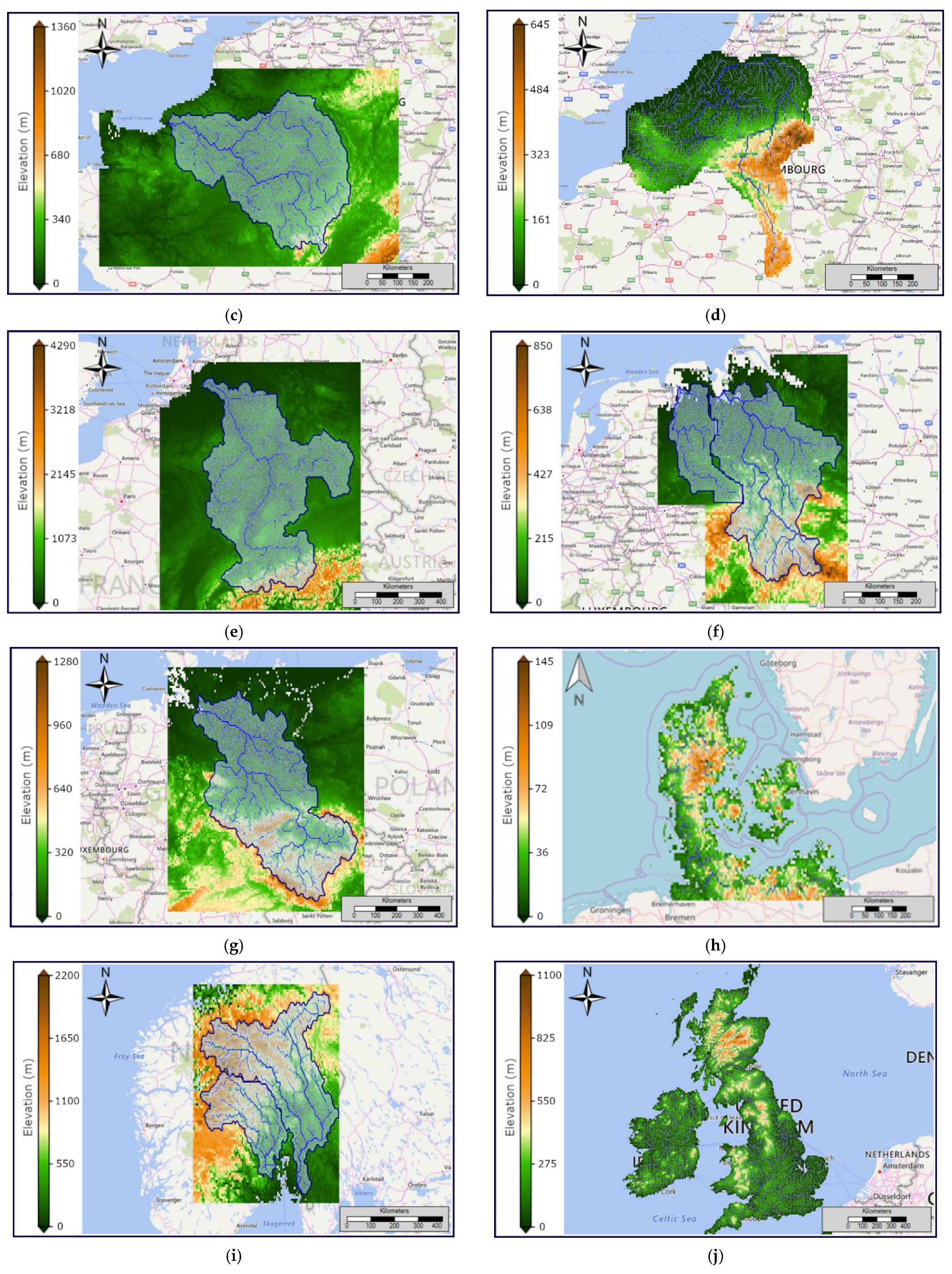


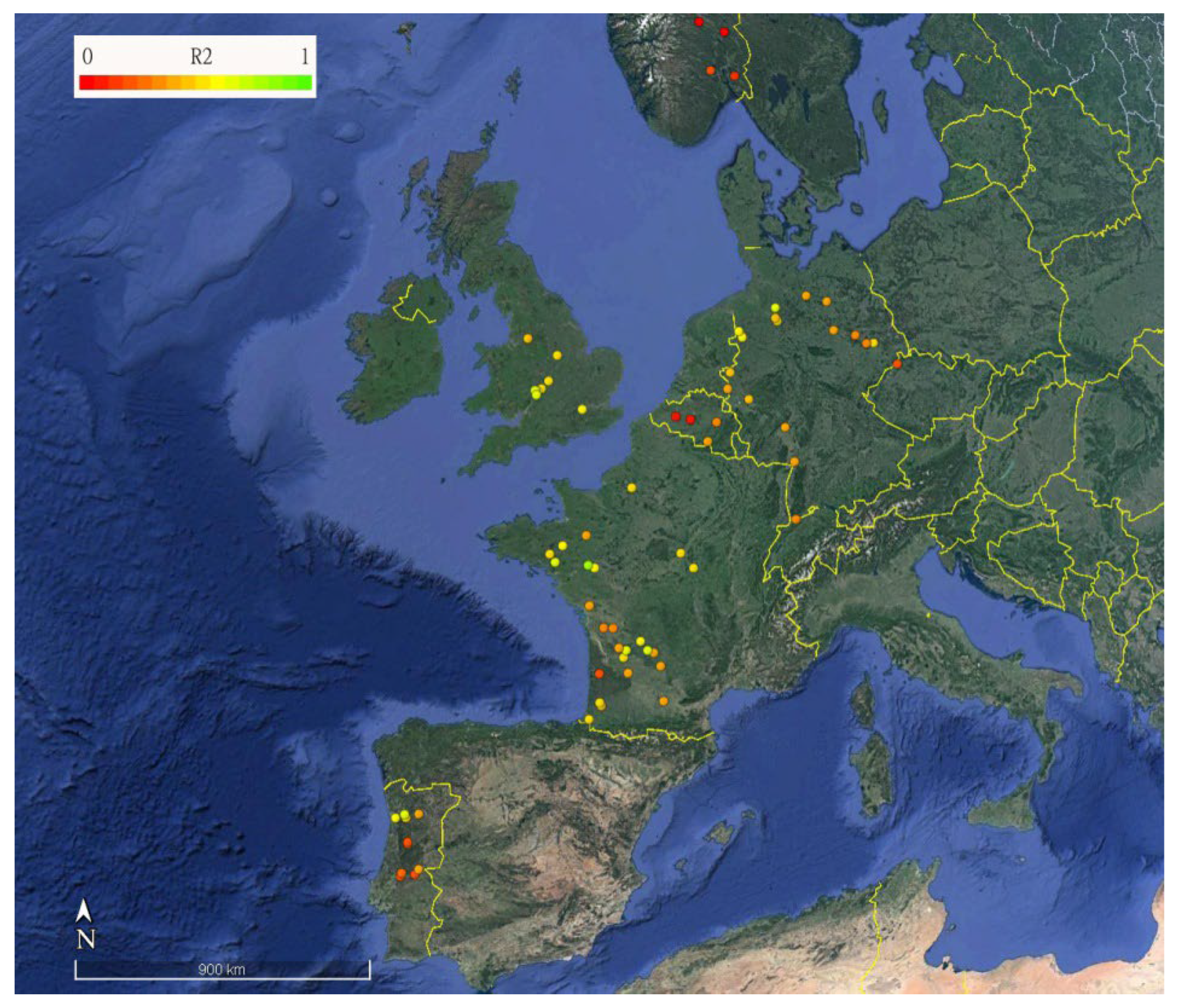

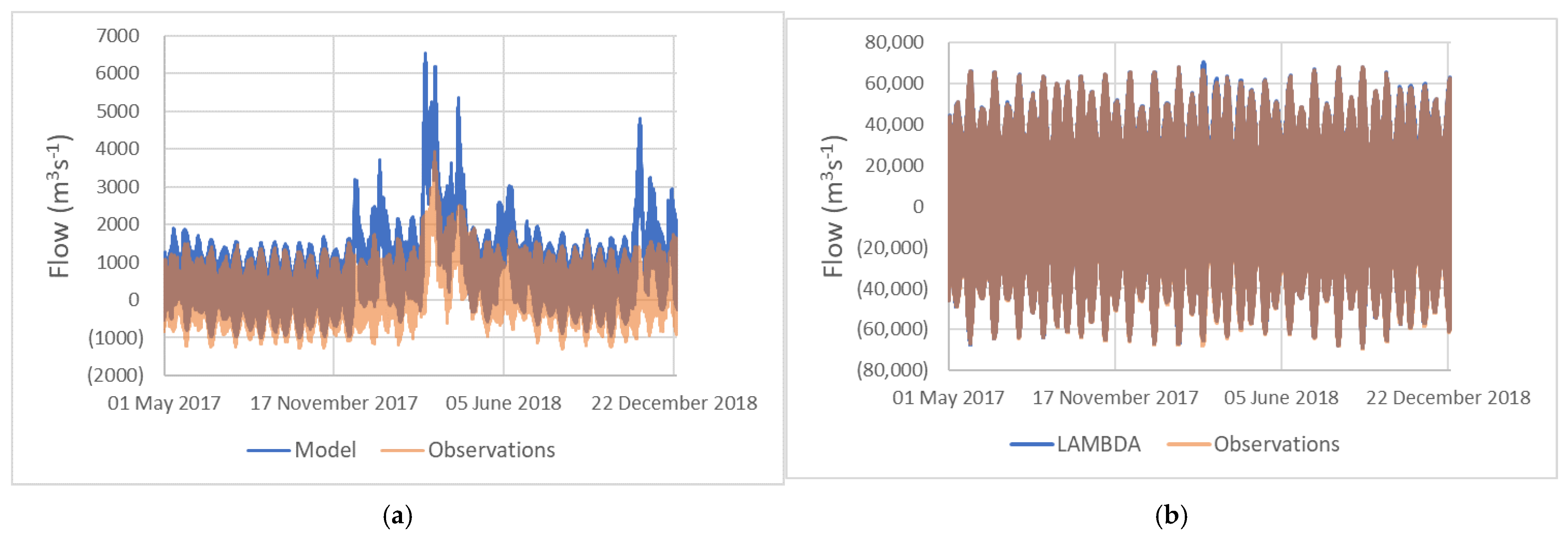


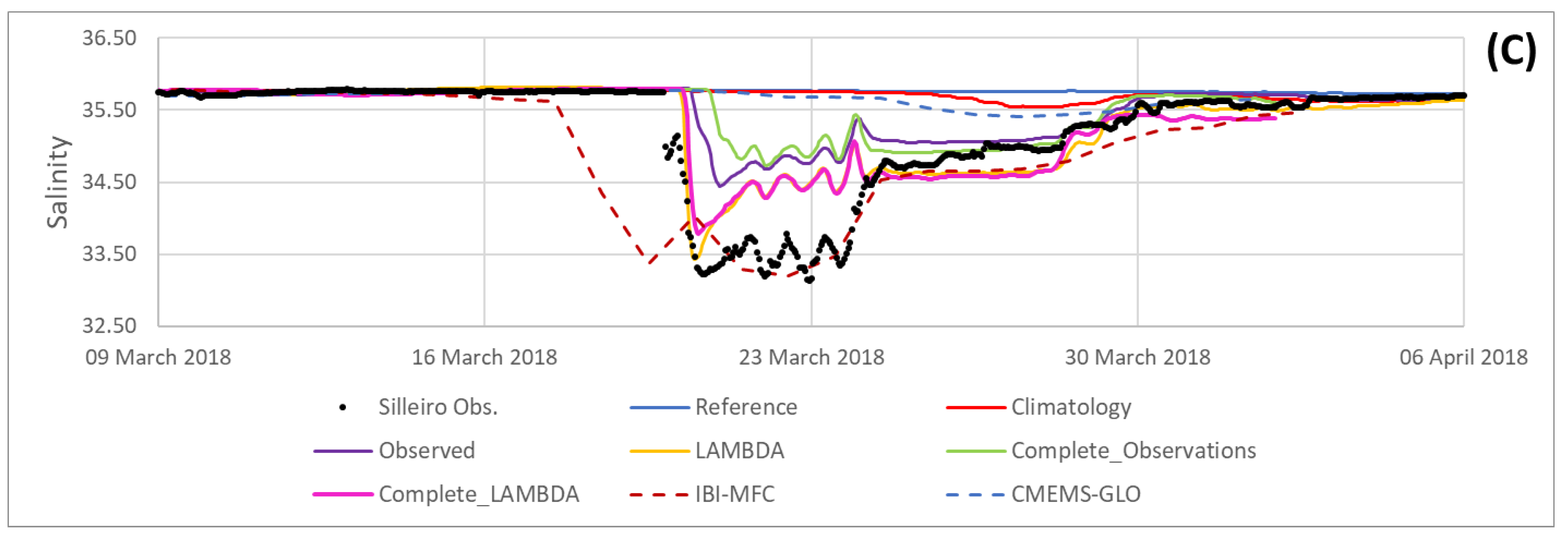

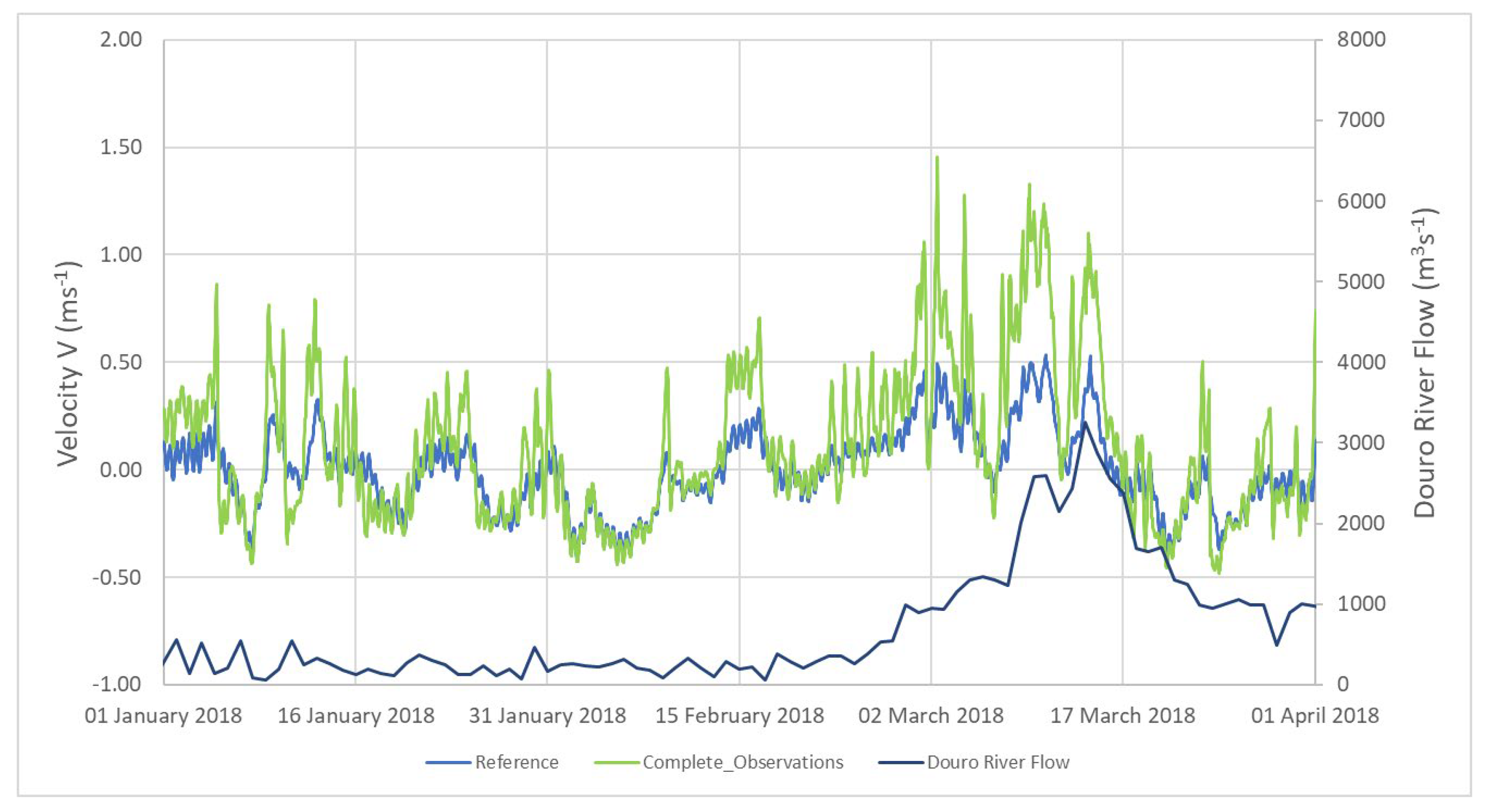

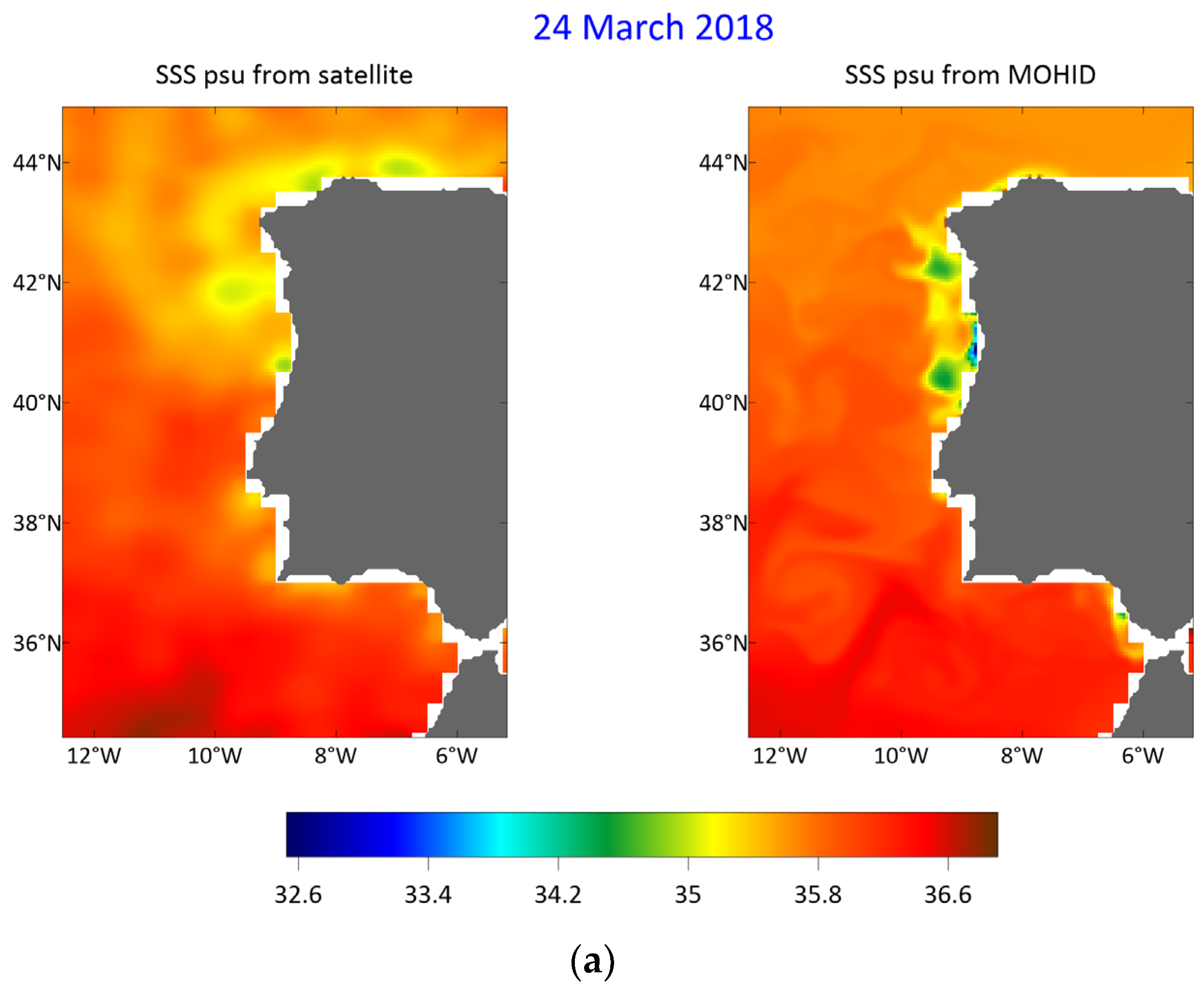



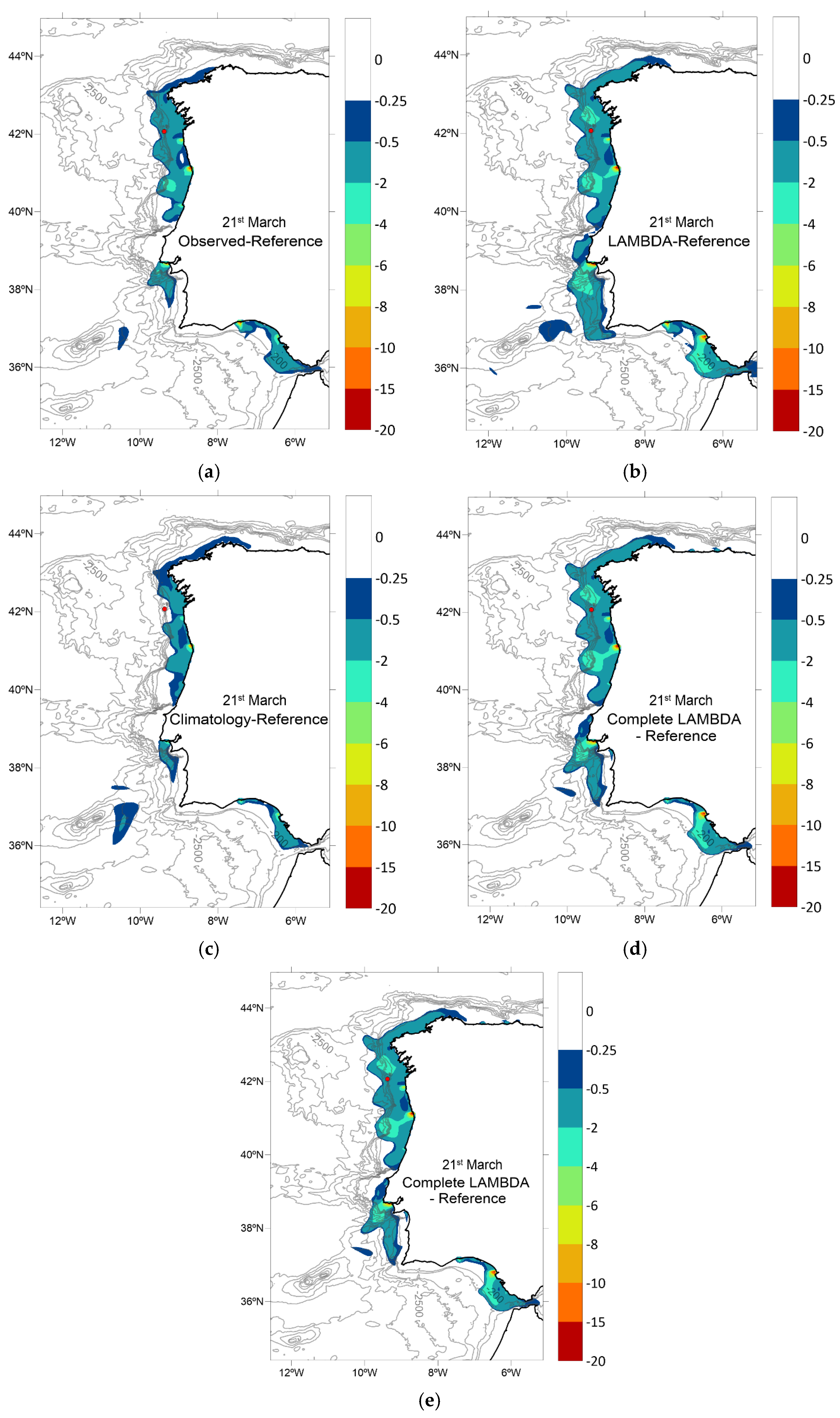
| Estuary | Mouth Orientation | Cell Length (Degrees) | Cell Width (Degrees) | Ocean Depth (m) | Ocean Salinity | Estuary Depth (m) | Longitude Mouth (° W) | Latitude Mouth (° N) |
|---|---|---|---|---|---|---|---|---|
| Guadalquivir (ES) | West | 0.11000 | 0.00475 | 20 | 36.2 | 10.0 | 6.440 | 36.785 |
| Sado (PT) | West | 0.08000 | 0.02000 | 10 | 36.0 | 8.0 | 8.930 | 38.470 |
| Tagus (PT) | West | 0.05000 | 0.06200 | 25 | 36.0 | 2.0–20.0 | 9.420 | 38.620 |
| Mondego (PT) | West | 0.00150 | 0.04500 | 6 | 36.0 | 2.0 | 8.880 | 40.143 |
| Douro (PT) | West | 0.02200 | 0.00272 | 8.2 | 36.0 | 8.2 | 8.700 | 41.140 |
| Minho (PT-ES) | West | 0.04000 | 0.00575 | 6 | 36.0 | 2.0 | 8.885 | 41.860 |
| Tagus | Douro | ||||||
|---|---|---|---|---|---|---|---|
| Max. | Min. | Avg. | Max. | Min. | Avg. | ||
| Observations | Flow (m3 s−1) | 68,231.84 | −68,663.64 | 29,264.75 * | 3936.56 | −1307.51 | 654.20 * |
| Velocity (m s−1) | 0.45 | −0.46 | 0.19 * | 0.42 | −1.30 | 0.21 * | |
| Temperature (°C) | 20.08 | 12.85 | 16.61 | 26.80 | 1.63 | 15.12 | |
| Salinity | 35.62 | 26.47 | 33.84 | 34.93 | 0.017 | 12.50 | |
| Model | Flow (m3 s−1) | 70,483.38 | −68,614.38 | 29,255.41 * | 6535.13 | −1017.03 | 1034.52 * |
| Velocity (m s−1) | 0.45 | −0.47 | 0.19 * | 0.33 | −2.21 | 0.33 * | |
| Temperature (°C) | 20.51 | 9.68 | 16.53 | 27.23 | 1.22 | 14.81 | |
| Salinity | 35.15 | 5.05 | 30.71 | 30.12 | 0.01 | 3.39 | |
| Property | Reference | Climatology | Observed | LAMBDA | Complete Observations | Complete LAMBDA | |
|---|---|---|---|---|---|---|---|
| R2 | Salinity | 0.07 | 0.00 | 0.65 | 0.72 | 0.61 | 0.78 |
| Temperature | 0.71 | 0.70 | 0.80 | 0.79 | 0.81 | 0.80 | |
| RMSE | Salinity | 0.52 | 0.52 | 0.32 | 0.26 | 0.35 | 0.23 |
| Temperature | 0.36 | 0.42 | 0.36 | 0.41 | 0.36 | 0.40 | |
| MAE | Salinity | 0.27 | 0.27 | 0.10 | 0.07 | 0.12 | 0.06 |
| Temperature | 0.13 | 0.18 | 0.13 | 0.17 | 0.13 | 0.16 |
Publisher’s Note: MDPI stays neutral with regard to jurisdictional claims in published maps and institutional affiliations. |
© 2022 by the authors. Licensee MDPI, Basel, Switzerland. This article is an open access article distributed under the terms and conditions of the Creative Commons Attribution (CC BY) license (https://creativecommons.org/licenses/by/4.0/).
Share and Cite
Campuzano, F.; Santos, F.; Simionesei, L.; Oliveira, A.R.; Olmedo, E.; Turiel, A.; Fernandes, R.; Brito, D.; Alba, M.; Novellino, A.; et al. Framework for Improving Land Boundary Conditions in Ocean Regional Products. J. Mar. Sci. Eng. 2022, 10, 852. https://doi.org/10.3390/jmse10070852
Campuzano F, Santos F, Simionesei L, Oliveira AR, Olmedo E, Turiel A, Fernandes R, Brito D, Alba M, Novellino A, et al. Framework for Improving Land Boundary Conditions in Ocean Regional Products. Journal of Marine Science and Engineering. 2022; 10(7):852. https://doi.org/10.3390/jmse10070852
Chicago/Turabian StyleCampuzano, Francisco, Flávio Santos, Lucian Simionesei, Ana R. Oliveira, Estrella Olmedo, Antonio Turiel, Rodrigo Fernandes, David Brito, Marco Alba, Antonio Novellino, and et al. 2022. "Framework for Improving Land Boundary Conditions in Ocean Regional Products" Journal of Marine Science and Engineering 10, no. 7: 852. https://doi.org/10.3390/jmse10070852






